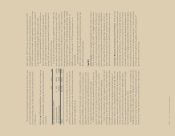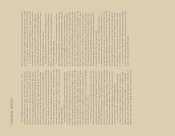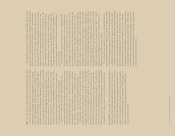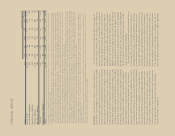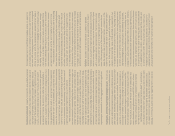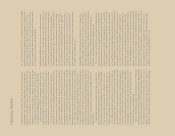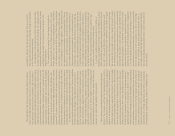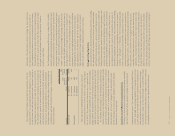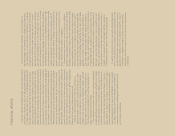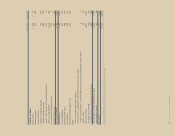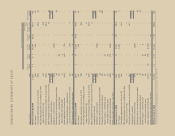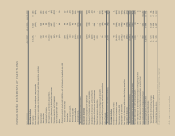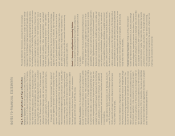Sara Lee 2011 Annual Report Download - page 76
Download and view the complete annual report
Please find page 76 of the 2011 Sara Lee annual report below. You can navigate through the pages in the report by either clicking on the pages listed below, or by using the keyword search tool below to find specific information within the annual report.
FINANCIAL REVIEW
fair value are outside the control of management and it is reasonably
likely that assumptions and estimates can change in future periods.
These changes can result in future impairments. Note 4 to the
Consolidated Financial Statements sets out the impact of charges
taken to recognize the impairment of goodwill and the factors which
led to changes in estimates and assumptions.
Self-Insurance Reserves The corporation purchases third-party
insurance for workers’ compensation, automobile and product and
general liability claims that exceed a certain level. The corporation
is responsible for the payment of claims under these insured limits,
and consulting actuaries are utilized to estimate the obligation
associated with incurred losses. Historical loss development factors
are utilized to project the future development of incurred losses,
and these amounts are adjusted based upon actual claim experi-
ence and settlements. Consulting actuaries make a significant
number of estimates and assumptions in determining the cost to
settle these claims and many of the factors used are outside the
control of the corporation. Accordingly, it is reasonably likely that
these assumptions and estimates may change and these changes
may impact future financial results.
Income Taxes Deferred taxes are recognized for the future tax
effects of temporary differences between financial and income tax
reporting using tax rates in effect for the years in which the differ-
ences are expected to reverse. Federal and state income taxes are
provided on that portion of foreign subsidiaries income that is
expected to be remitted to the U.S. and be taxable.
The corporation’s effective tax rate is based on pretax income,
statutory tax rates and tax planning opportunities available in the
various jurisdictions in which the corporation operates. There are
inherent uncertainties related to the interpretation of tax regulations
in the jurisdictions in which the corporation transacts business. We
establish reserves for income taxes when, despite the belief that
our tax positions are fully supportable, we believe that our position
may be challenged and possibly disallowed by various tax authorities.
The corporation’s recorded estimates of liability related to income
tax positions are based on management’s judgments made in
consultation with outside tax and legal counsel, where appropriate,
and are based upon the expected outcome of proceedings with
worldwide tax authorities in consideration of applicable tax statutes
and related interpretations and precedents. These reserves include
penalties and interest on these reserves at the appropriate statutory
interest rates and these charges are also included in the corporation’s
effective tax rate. The ultimate liability incurred by the corporation
may differ from its estimates based on a number of factors, includ-
ing the application of relevant legal precedent, the corporation’s
success in supporting its filing positions with tax authorities, and
changes to, or further interpretations of, law.
employs market multiples of revenues or earnings for companies
comparable to the corporation’s operating units. Management
believes the assumptions used for the impairment test are consis-
tent with those utilized by a market participant performing similar
valuations for our reporting units. A separate discount rate derived
from published sources was utilized for each reporting unit and,
on a weighted average basis, the discount rate used was 9.8%.
In the third quarter of 2011, management indicated that the
International Bakery operations were under strategic review. The
asset disposal groups comprising the International Bakery opera-
tions were tested for impairment under the held and used model
in 2011 and it was determined no impairment was necessary.
Subsequent to year end, management decided they will divest the
Spanish bakery and French dough businesses, reported as part of
the International Bakery segment, requiring that these businesses
be tested for impairment under the available for sale model in 2012.
Evaluating the recoverability of the assets of a business classified
as available for sale follows a defined order in which the recoverabil-
ity of goodwill, indefinite-lived intangible assets and other assets are
tested for impairment prior to depreciable fixed assets and intangi-
bles. The impairment test for these businesses will include currency
translation adjustment balances which are in a significant loss
position estimated at $100 million for the Spanish bakery business
and $160 million for the French dough business. It is estimated that
in 2012 the corporation will recognize impairments for the Spanish
bakery business of approximately $85 million to $100 million and
for the French dough business of approximately $150 million to
$160 million.
The beverage operations in Brazil, which are reported within
the International Beverage segment, have $47 million of goodwill
generated by two separate acquisitions made in 2009 and 2011.
In the annual goodwill impairment test conducted in the fourth
quarter of 2011, the International Beverage Brazil reporting unit
had an estimated fair value in excess of net asset carrying value
of 9%. Holding all other assumptions constant at the test date, a
100 basis point increase in the discount rate used for this reporting
unit would reduce the enterprise value by 4% indicating no impairment.
Although management currently believes the beverage operations
in Brazil can support the value of its recorded goodwill, a change in
assumptions driven by macro-economic conditions or degradation
in the Brazilian consumer coffee market that undermines the report-
ing unit’s ability to achieve targeted profit levels may result in an
impairment of their recorded goodwill.
There are inherent assumptions and estimates used in developing
future cash flows requiring management’s judgment in applying these
assumptions and estimates to the analysis of goodwill impairment
including projecting revenues and profits, interest rates, the cost of
capital, tax rates, the corporation’s stock price, and the allocation of
shared or corporate items. Many of the factors used in assessing



